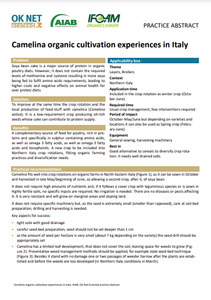{Tool} Camelina organic cultivation experiences in Italy (OK-Net EcoFeed Practice abstract). Creator(s): Micheloni, Cristina. Issuing Organisation(s): AIAB - Associazione Italiana Agricoltura Biologica. OK-Net Ecofeed Practice abstract. (2021)
|
PDF
- Published Version
- English
(Camelina organic cultivation experiences in Italy)
623kB | |
|
PDF
- Published Version
- Italian/Italiano
1MB | |
![[thumbnail of 2022-06-17 13_34_36-Camelina organic cultivation experiences in Italy.png]](/39637/4.hassmallThumbnailVersion/2022-06-17%2013_34_36-Camelina%20organic%20cultivation%20experiences%20in%20Italy.png)  Preview |
Image (PNG)
- Cover Image
- English
61kB |
Summary in the original language of the document
A complementary source of feed for poultry, rich in pro-teins and specifically in sulphur containing amino acids, as well as omega 3 fatty acids, as well as omega 3 fatty acids and tocopherols. A new crop to be included into Northern Italy crop rotations, fitting organic farming practices and diversification needs.
Camelina fits well into crop rotations on organic farms in North-Eastern Italy (Figure 1), as it can be sown in October and harvested in late May/beginning of June, so allowing a second crop, after it, of soya bean.
It does not require high amounts of nutrients and, if it follows a cover crop with leguminous species or is sown in highly fertile soils, no specific inputs are required. No irrigation is needed. There are no diseases or pests affecting it. It is very resistant and will grow on marginal areas and sloping land.
It does not require specific machinery but, as the seed is extremely small (smaller than rapeseed), care at soil-bed preparation, drilling and harvesting is needed.
Key aspects for success:
• light soils with good drainage
• careful seed-bed preparation, seed should not be set deeper than 1 cm
• as the amount of seed per hectare is very small (about 7 kg depending on the variety) the seed drill should be appropriately set
• Camelina has a limited leaf development, that does not cover the soil, leaving space for weeds to grow (Fig-ure 2). Preventative weed management methods should be applied, for example stale seed-bed technique (Figure 3). Besides it stand with no damage one or two passages of weeder harrow after the plants are estab-lished and before the weeds are too developed (in Northern Italy conditions in March).
| EPrint Type: | Practice tool |
|---|---|
| What problem does the tool address?: | Soya bean cake is a major source of protein in organic poultry diets. However, it does not contain the required levels of methionine and cysteine resulting in more soya being fed to fulfil amino acids requirements, leading to higher costs and negative effects on animal health for over proteic diets. |
| What solution does the tool offer?: | To improve at the same time the crop rotation and the local production of feed-stuff with camelina (Camelina sativa). It is a low-requirement crop producing oil-rich seeds whose cake can contribute to protein supply. |
| Country: | Italy |
| Type of Practice Tool: | Practice abstracts |
| Keywords: | soybeans, soya bean cake, feeding, layer chickens, layers, broiler chickens, broilers, poultry, proteins, amino acids |
| Agrovoc keywords: | Language Value URI English soybeans http://aims.fao.org/aos/agrovoc/c_14477 English feeding http://aims.fao.org/aos/agrovoc/c_2838 English layer chickens http://aims.fao.org/aos/agrovoc/c_12109 English broiler chickens http://aims.fao.org/aos/agrovoc/c_9435 English proteins http://aims.fao.org/aos/agrovoc/c_6259 English amino acids http://aims.fao.org/aos/agrovoc/c_342 |
| Subjects: | Crop husbandry > Production systems > Cereals, pulses and oilseeds Animal husbandry > Feeding and growth Animal husbandry > Production systems > Poultry |
| Research affiliation: | European Union > Horizon 2020 > OK-Net EcoFeed European Union > Horizon 2020 > OK-Net EcoFeed > OK-Net Ecofeed Tools Italy > AIAB European Union > Organic Farm Knowledge |
| Horizon Europe or H2020 Grant Agreement Number: | 773911 |
| Related Links: | https://organic-farmknowledge.org/tool/39637, https://aiab.it/, https://www.facebook.com/organicfarmknowledge/posts/235970868315555, https://twitter.com/farm_knowledge/status/1383064857403125771, https://twitter.com/farm_knowledge/status/1541335675294961664, https://www.facebook.com/organicfarmknowledge/posts/pfbid026N7HoM5agv1uUdx4g3kXuV82fbe1XTJ9MhsgbFszr3k1ETG6BKyxVGdxGfiXnJhbl |
| Project ID: | ofk |
| Deposited By: | Forschungsinstitut für biologischen Landbau, FiBL |
| ID Code: | 39637 |
| Deposited On: | 31 Mar 2021 10:42 |
| Last Modified: | 02 May 2024 10:32 |
| Document Language: | English |
| Status: | Published |
Repository Staff Only: item control page

 Download Statistics
Download Statistics Download Statistics
Download Statistics
